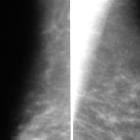Poland syndrome























Poland syndrome refers to a congenital unilateral absence of the pectoralis major and minor muscles and is a recognized cause of unilateral hyperlucent hemithorax.
Epidemiology
Poland syndrome is usually sporadic, although rare familial cases have been described . It is rare, with an estimated incidence of 1:36,000-50,000 . There does not appear to be a side or gender predilection.
Although rare, an association with Möbius syndrome has been described (thus Poland-Möbius syndrome) as well as with morning glory syndrome and Pierre-Robin syndrome .
Clinical presentation
The abnormality is usually evident at birth due to an asymmetry of the chest and frequent and ipsilateral abnormalities, most frequently syndactyly . Spectrum of abnormalities includes:
- aplasia or hypoplasia of
- pectoralis major (most common)
- pectoralis minor
- ipsilateral 2 to 5 ribs
- ipsilateral breast or nipple
- upper limb abnormalities
- small hand and brachysyndactyly
- simian crease of the affected extremity
Pathology
No definite cause has as yet been identified, although it is thought to result from an isolated vascular insult in early gestation (involving embryonic subclavian and vertebral arteries).
Radiographic features
Mammography
May be seen as hypoplasia of the breast or the pectoralis major muscle (thus absent on MLO view).
Plain radiograph
On chest radiographs, Poland syndrome is one of the classic causes for a unilateral hyperlucent hemithorax, and should be considered when other causes do not explain asymmetry of the chest.
CT/MRI
Although clinical examination usually suffices to make the diagnosis, cross-sectional imaging will elegantly outline abnormalities.
Treatment and prognosis
The condition is benign and depending on the degree of involvement of the upper extremity may be asymptomatic. Cosmetic reconstructive surgery may be considered (e.g. breast implant).
History and etymology
It was first described by Sir Alfred Poland, English surgeon (1822-1872), in 1841, after he dissected the body of a convict named George Elt at Guy's Hospital .
Differential diagnosis
For hypoplastic breast/absent tissue on one side on mammography, consider:
- amazia: absence of breast parenchyma
- amastia: absence of breast tissue
- can occur from an excision of a pre-puberal breast bud or from chest wall irradiation during childhood
For a unilateral hyperlucent hemithorax on a chest radiograph see the main article: unilateral hyperlucent hemithorax.
Siehe auch:
- einseitig vermehrte Transparenz Thorax
- Musculus pectoralis major
- Syndaktylie
- einseitige Nierenagenesie
- Pectoralisschatten
- Amazie
- Amastie
und weiter:

 Assoziationen und Differentialdiagnosen zu Poland-Syndrom:
Assoziationen und Differentialdiagnosen zu Poland-Syndrom:




